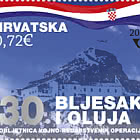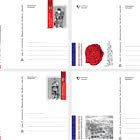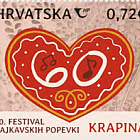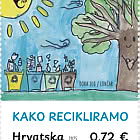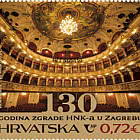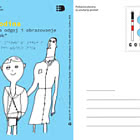Croatia - France Joint Issue
Vase, circa 1884
Production: Nancy, Meurthe-et-Moselle, France
Location: Musée d'Orsay, Paris, France
Émile Gallé (Nancy, 1846 – 1904) is one of the leading representatives of the French Art Nouveauin the creation of useable and decorative items made of ceramics and glass. He was just as successful in the realisation of the versatility of his creative interests with furniture design. The trade mark of Gallé's specific style is the luxurious inventory of decorative ornaments inspired by his interest in botany and symbolism giving him the title of the greatest glass painter.
He gained his first experiences with ceramics and glass decorating in Nancy. After that, he studied botany, mineralogy and art history in Weimar. Once he completed his formal education, he continued his training at the Burgun, Schverer & Co. glass factory in Meisenthal and then finally returned to Nancy where he founded and managed his own company. With his inventive management of the workshop with more than 300 employed craftsmen, Gallé, in the modern design history, is known as the precursor of a modern art director. The production, in addition to small handmade series, also included a serial production of cast glass followed by application of decorations. He used experimentation as his fundamental work method.
He achieved his first great success at Exposition Universellein Paris in 1878 that encouraged him to take on a more daring approach to design. In Gallé's design, nature is the source of decorations as well as glass shapes. In addition, he was fascinated by the Japanese arts, especially graphics that were the reason his vase décor was more liberated. At the same time, experimenting, as a method, brought a richness of shapes and tones of unusual landscapes, lotuses, orchids, ferns and forest flowers, butterflies, birds and crickets, as well as other motifs that symbolise the newly discovered beauty. However, this is not only about superb decoration, but also Gallé's preoccupation with the life force in nature, one of the universal themes of new arts at the turn of the century.
Vase, 1901
Production: Johann Loetz Witwe, Klostermühle, for E. Bakalowits & Sohne, Vienna
Location: Museum of Arts and Crafts, 807, Zagreb, Croatia
Antonija (Antoinette) Krasnik (Lovinac, 1874 – Zagreb, 1956) is one of the first authors from the turn on the 20thcentury who were professionally involved in design and decorative arts. After completing her studies and first art lessons in Zagreb, she went to Vienna where she studied in the class of renowned Koloman Moser at Kunstgewerbeschule. Following Vienna, she trained in Paris and exhibited at many decorative art shows in Vienna, Berlin, Munich, London, St. Louis, Torino, Paris and elsewhere. Her works stood out with their originality in terms of shape and superb quality of execution and were purchased for museum collections and published in the most important European art magazines, such as Art et décoration.
From the time of her education, she was successful in various media, from painting and sculpting, to decorative shaping of items made of glass, metal, ceramics, furniture, jewellery, textiles, clothing and fashion accessories. Flora and fauna were an endless source of inspiration for ornaments that she blended with superbly shaped items.
A characteristic example of refined aesthetics of shaping is a vase made of iridized transparent glass in blue-green shades with an applique of silver leafs in iris flower shapes on elongated intertwined thin stems, one of the favourite Art Nouveau motifs. The cone-shaped vase with broadened sides made by glassblowing that turn into rounded teardrop-shaped brackets was made in the Johann Loetz Witwe glass factory in the Czech Republic for the company Bakalowits & Sohne from Vienna. Proof of the success of the design is the fact that it was produced in as many as nine decor versions.
Coincidentally, the works of Antonija Krasnik and Émile Gallé were exhibited at the same shows, including Exposition Universellein Paris in 1900. Even though their careers were very different, their inventiveness in terms of shapes and experimenting with materials makes them authentic representatives of modern design.
Jasna Galjer
Professor at the Faculty of Humanities and Social Sciences
University of Zagreb
Croatia - Recommended stamp issues
WOPA+ recommended stamp issues
| Avatar - Fire and Ash |
| Issued: 03.12.2025 |
| ›New Zealand |
| 50th Anniversary of the Founding of the 24th November Bar Scout |
| Issued: 24.11.2025 |
| ›Montenegro |
| Krisjanis Valdemars |
| Issued: 02.12.2025 |
| ›Latvia |
| Sign Language - Good |
| Issued: 02.12.2025 |
| ›Bosnia and Herzegovina - Republic of Srpska |
| In Memory of the Fallen and Murdered on October 7, 2023 |
| Issued: 08.10.2025 |
| ›Israel |
| Annual Collection Folder (New York) |
| Issued: 05.12.2025 |
| ›United Nations |
| Year Set |
| Issued: 24.11.2025 |
| ›Isle of Man |
| Shipping in the 17th and 18th Centuries - Peat Shipping |
| Issued: 05.12.2025 |
| ›Netherlands |









